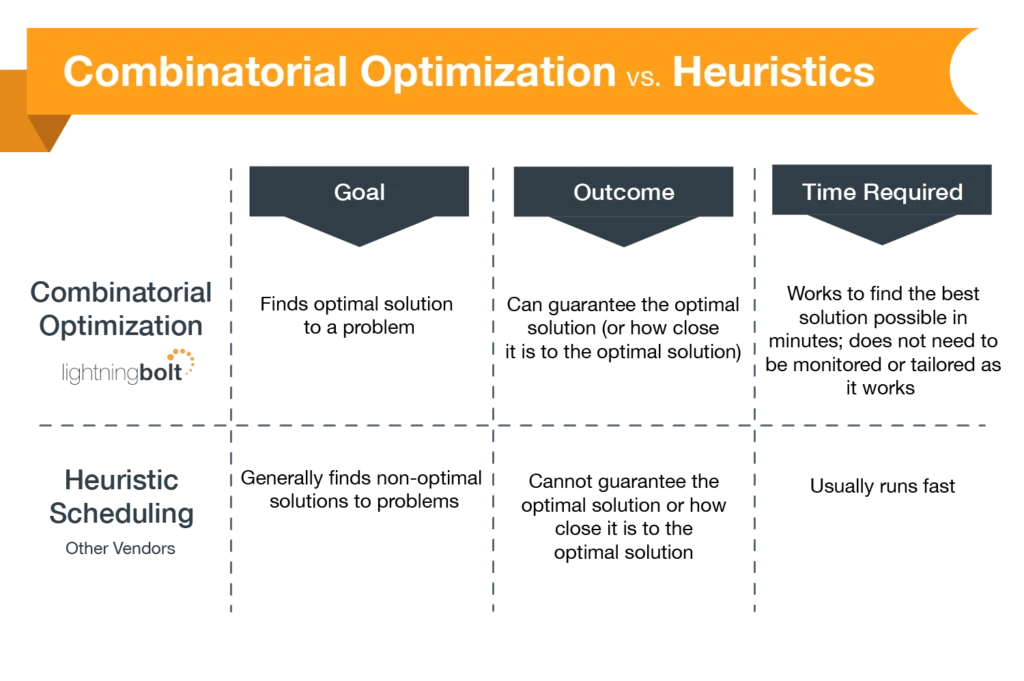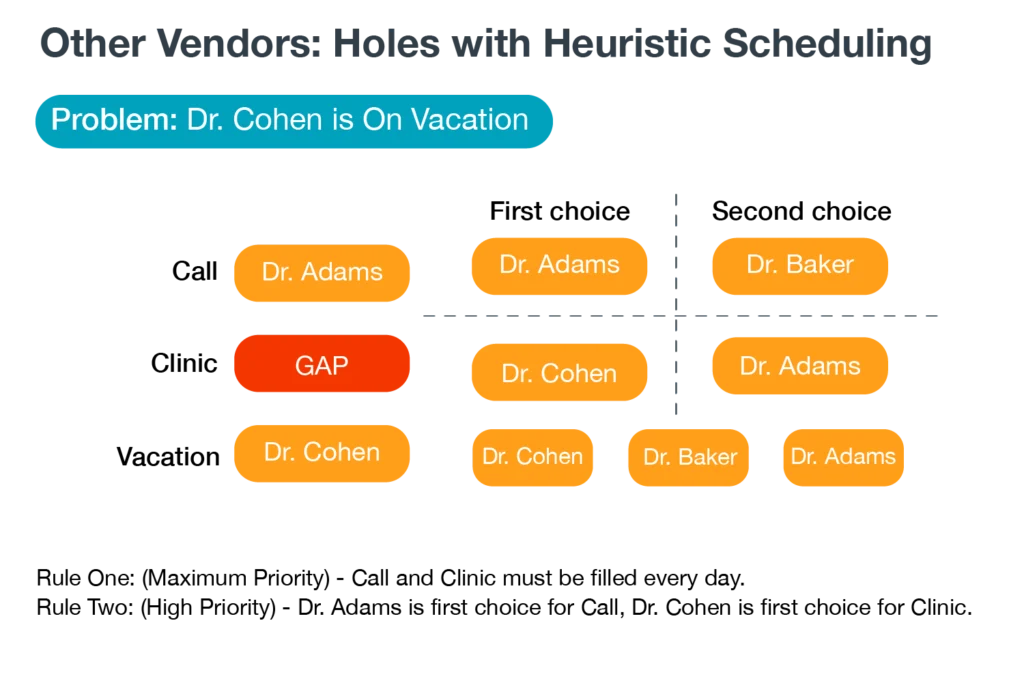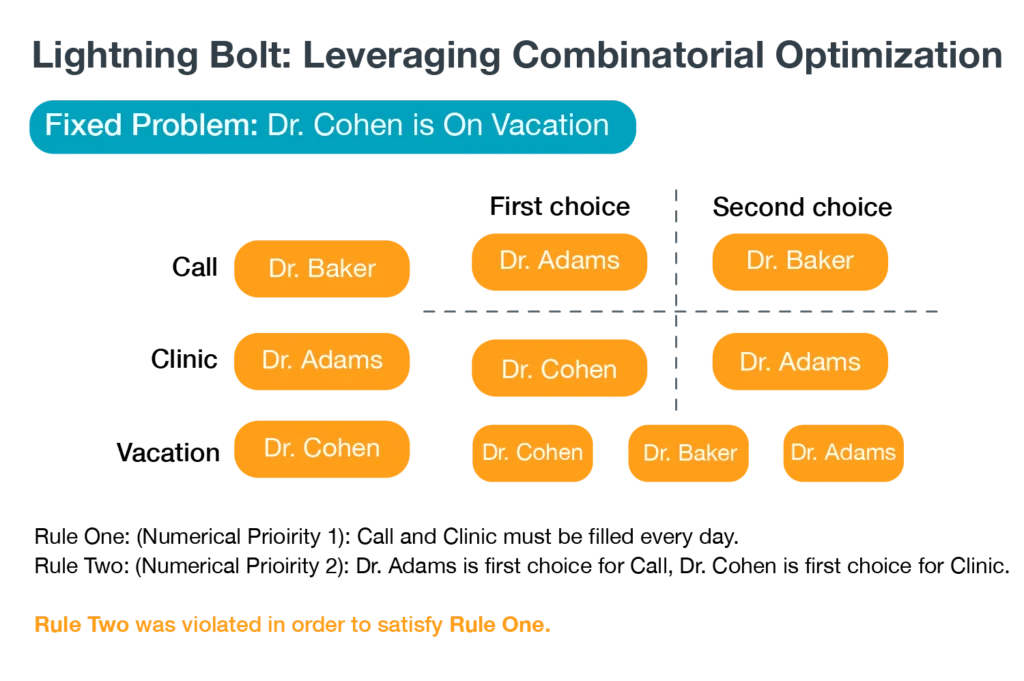The Power of Combinatorial Optimization
TABLE OF CONTENTS

For far too long, Excel spreadsheets have been the de facto solution for creating and editing shift and call schedules for hospitals and health systems. Other industries have similarly managed complex schedules by hand, but the key difference is that most of them moved to more capable tech-based scheduling systems decades ago.
Take Major League Baseball, for example. A typical MLB season features more than 1,200 players and 2,400 games. The thought of building optimized 162-game schedules by hand for 30 different teams is daunting. For decades, MLB used a combination of computer programs and manual handiwork to tackle this problem, but that all changed for the better in 2005 when MLB shifted scheduling duties entirely to tech powered by combinatorial optimization.
What is Combinatorial Optimization?
Combinatorial optimization is a mathematical process for finding the best possible solution from a finite set of possibilities. The set of possibilities becomes a math problem and is worked until the best solution—according to predetermined objectives and functions—is found. To throw it back to MLB for a second, their combinatorial optimization-based scheduling tech can combine, examine, and recombine any number of game-determining factors until the most optimal schedule for the season is built. This inherent flexibility is a major strength of combinatorial optimization—companies can use it to plan logistics, production, pricing, and even schedules for healthcare providers.

But before we continue with combinatorial optimization, a brief word about heuristic scheduling.
Is Combinatorial Optimization Better Than Heuristic Scheduling?
A number of vendors today offer technology that uses heuristics to build schedules. The goal with heuristic scheduling is to find a quick solution that falls within an acceptable range of accuracy without resource conflicts. If you’re coming from a pure paper schedule, that’s an improvement, but that falls short of the goal of combinatorial optimization, which is to find the best solution possible. Here’s a quick comparison of the two methods:

Both methods yield auto-generated schedules, so the ultimate question is this: Would you rather get quick solutions that often have to be “fixed” after the fact? Or would you rather get the best solutions that are optimized out of the gate?
Using Combinatorial Optimization to Build Better Schedules
For over 20 years, Lightning Bolt Scheduling has relied on the power of combinatorial optimization to build the best schedules for customers according to their unique requirements. Schedulers can enter an unlimited number of scheduling rules and preferences into the Lightning Bolt system, and the solution produces fully optimized schedules in minutes. It’s able to hierarchize rules based on numerical priority—meaning rules are assigned a numerical value based on how essential they are. This allows lower-priority rules to be broken to ensure that the most critical rules are always followed.
Other solutions allow rules to be assigned high, medium, or low priority. If there are more than three rules, at least two will be the same priority level, resulting in schedule gaps because the software can’t make independent decisions when comparing two assignments with the same priority level. Lightning Bolt uses numerical values to ensure that every rule is considered based on a true, more granular level of importance. Additionally, it will always break lower-priority rules first to ensure the outcome is a schedule that meets all critical requirements.
Here’s a use case to demonstrate how this all works:
Use Case: Prioritize Rules to Boost Work-Life Balance
As a scheduler for a small cardiology practice, you’re examining the shift schedule for the Monday night call shift. Dr. Adams is the first choice for the call shift based on his preferences and recent schedules. Dr. Baker is second on the list. For clinic, Dr. Cohen is the first choice, and Dr. Adams is the second choice. After double checking time-off requests, you see that Dr. Cohen requested vacation time. If you used a heuristic scheduling model for this situation, it wouldn’t be possible to meet everybody’s preferences without leaving a gap in clinic coverage. Again, heuristic scheduling finds quick solutions—not always the best solutions.

How would Lightning Bolt handle this?
At your clinic, you’ve created two essential rules for Lightning Bolt to follow when building schedules. Rule One says that call and clinic shifts must be filled every day. It’s been given a numerical value of 1, meaning it must be prioritized above all other rules and cannot be broken. Rule Two says that Dr. Adams is the first choice for call and Dr. Cohen is the first choice for clinic and has been given a numerical value of 2. This means it is also an essential rule to follow, but it can be broken to ensure that Rule One is met. The solution automatically grants time-off requests when possible, so it would be aware of Dr. Cohen’s request for vacation time.

Because Rule One cannot be broken, Lightning Bolt would break Rule Two (the lower-priority rule based on its numerical priority level) to place Dr. Baker in the call shift and Dr. Adams in the clinic shift before granting Dr. Cohen his preferred time off for vacation. This rule breaking system, based on numerical priority levels, is what gives Lightning Bolt’s combinatorial optimization-powered algorithm the ability to produce an optimal schedule every time.
The Benefits of Schedules Built by Combinatorial Optimization
Auto-Generate Best-in-Class Schedules
- Auto-generation that builds the best schedule every time
- Rule violations are minimized and demand is met
- Schedulers save time—and often a lot of time—versus manual scheduling
- Lightning Bolt’s dedicated team of data scientists supports and maintains the algorithmic technology used in combinatorial optimization
No Such Thing as Too Much Complexity
- Combinatorial optimization can consider an almost infinite number of rules when building schedules
- No scheduling requirements or sub-specialty needs are too odd or too complex for Lightning Bolt to handle
- This flexibility means the solution and its outputs can be tailored very closely to the needs of any team, practice, group, facility, or even health system
More Time for Patient Care
- Schedulers—who are sometimes providers themselves—get to spend more time caring for patients
- Less schedule friction means better time management
- Scheduled breaks improve provider morale and boost patient-provider relationships
Detailed Insight with Advanced Analytics
- Detailed reports available with important scheduling data
- Improves decision making and confidence level for schedulers
- Provides insight about solution adoption and utilization
- Highlights resource utilization, such as OR rooms that could be used more efficiently
- Schedule and shift equalization can highlight which providers are used too much or too little for more detailed staffing reports
Promotes Provider Wellness and Satisfaction
- Ability to create fairer schedules for providers
- Providers can express their own schedule and shift preferences
- Increases scheduling transparency for all team members
- Insight into clinicians whose schedule characteristics may be more indicative of burnout
Combinatorial optimization is so much more than just auto-generated schedules—any heuristic scheduling model can do that. With a solution like Lightning Bolt that uses this more powerful technology, auto-generated schedules also happen to be complete, balanced, and optimized. In high-pressure environments like hospitals and medical clinics, better provider schedules make a world of difference.
So, schedulers, it’s time to ditch the Excel sheets in favor of rule-based scheduling that boosts efficiency, improves resource management, and enhances provider satisfaction. Contact us today to unlock the power of combinatorial optimization.



